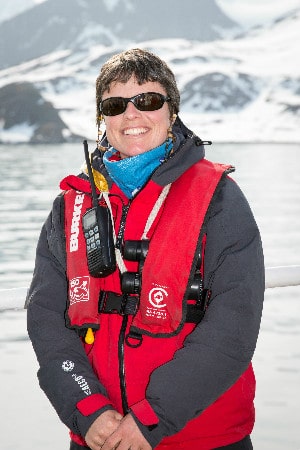 Venturing out to sea as a Sea Cadet during her teens, Heidi then left home to work as a deckhand on a schooner on the west coast of her native Canada. Further travels to Bermuda and Canada’s west coast ignited a keen interest in the natural world.
Venturing out to sea as a Sea Cadet during her teens, Heidi then left home to work as a deckhand on a schooner on the west coast of her native Canada. Further travels to Bermuda and Canada’s west coast ignited a keen interest in the natural world.
Following her passion, Heidi worked on wilderness adventure boats to put herself through a Marine Biology degree at the University of Victoria in British Columbia. She has been enthusiastically interpreting the natural world ever since.
Heidi is a director of the Marine and Education Research Society, and has helped with the first Photo ID catalogue of minke whales in British Columbia. She has also run a research vessel with her husband, completing many projects including a large baseline study of all marine mammals and seabirds on the British Columbia coast for Raincoast Conservation Society.
Heidi has recently spent three years exploring the South Pacific on a small yacht with her husband, however she has now returned to land (for now) and set up home in Hobart, Tasmania. 2016/17 will be her seventh Antarctic season as an expedition naturalist.
What is your area of expertise on board & tell us what your role involves?
I am the naturalist on board Polar Pioneer. I think that it’s the best job in the world! I educate our passengers about the wildlife and habitats that they are travelling through in the Arctic and Antarctic. It’s not difficult to garner enthusiasm for penguins or polar bears, but I think that everyone appreciates learning a bit more about the ecosystem that these animals are a part of. A little bit of knowledge about the lives of the wildlife helps everyone when observing whether on a walk or a zodiac cruise.
How did you start working on expedition ships in the poles?
While I was a marine biology student I started working on an ecotourism sailboat on the west coast of Canada and Alaska. It was a great summer job for a young biology student and I worked with some fantastic naturalists, who showed me how to identify individual killer whales (orca) and their family groups, and also got me really interested in seabirds. It was a great challenge and natural progression to take those skills to the southern ocean and the high Arctic.
Describe an average day’s work in Antarctica and the Arctic aboard an expedition ship?
Each day on board an expedition ship for me starts with going out on deck before breakfast to see where we are and what wildlife might be around. Every day is different which is why the job is always interesting. Throughout the day I will likely be walking on shore with our passengers or driving a zodiac during a cruise. Either way I get to look for wildlife and beautiful scenery and share it with other people.
What do you consider the best part of working in Antarctica and the Arctic?
The best part of working in the Arctic or Antarctica is spending lots of time in the ice! It is really other-worldly and it is always hard for me to explain the fascination to someone who hasn’t been there. Whether the ship is moving through floes of frozen sea ice or passing sculptures of glacial icebergs, it is a beautiful wild world.
Who are your female icons?
I went to high school in the same small town as Roberta Bondar, she was the first Canadian woman astronaut in space. She was an icon for me growing up because she was a real explorer! She didn’t just pick an easy or “normal” profession, but let her curiosity and intelligence open up unusual opportunities.
What does International Women’s Day mean to you? Is it important that we have one?
I have had so many more opportunities to study, explore and work, than the women of previous generations. I have an elderly aunt who I love to visit. She was a traveller, and has such a curiosity for the world, but grew up in the 40’s in Canada and couldn’t make the same choices that I did. I feel that International Women’s Day celebrates the open doors that women have now in many parts of the world and also acknowledges the challenges that many women still face.

